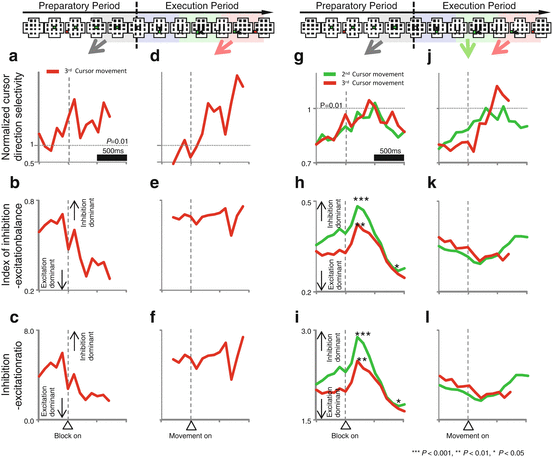Fig. 1
The event sequence in the path-planning task. Green, red and yellow squares denote the cursor, final-goal, and GO signals, respectively
2 Methods
The details of the experimental procedures have been previously described [5–7]. Two Japanese monkeys were trained to perform a path-planning task that required step-by-step cursor movements, controlled with the manipulanda, to reach a goal in a checkerboard-like maze. Supination and pronation of each forearm was assigned to move the cursor in four directions. We recorded the single-unit activities in the lPFC of these monkeys.
Putative PNs and INs were classified based on their action potential waveform [8–10]. Spike-width was defined as:


An obvious distribution with two peaks was observed: putative PNs were defined as neurons with a spike-width of >0.8 ms, while INs had a spike-width of <0.8 ms. The index of the inhibition-excitation balance at each time was calculated using the following equation:
 In addition, we used the inhibition/excitation ratio (average FR of INs / average FR of PNs) to evaluate the IN-PN balance. Statistical significance was assessed using the bootstrapping method (10,000 times).
In addition, we used the inhibition/excitation ratio (average FR of INs / average FR of PNs) to evaluate the IN-PN balance. Statistical significance was assessed using the bootstrapping method (10,000 times).

3 Results
Of 299 neurons, 54 were classified as INs, and 245 as PNs. For the first cursor movements, 26 INs and 89 PNs showed significant selectivity during the execution period, 28 INs and 87 PNs for the second, and 25 INs and 84 PNs showed selectivity for the third.
Figure 2 shows examples of simultaneously recorded third cursor movement-selective IN (Fig. 2a) and PN (Fig. 2b). Both neurons had enhanced firing rates during the preparatory and execution periods in the trials when the monkey made leftward cursor movements at the third step. It should be noted, however, that these neurons also showed gradually elevated activity before block-onset, with slightly higher elevation detected in IN.


Fig. 2
An example of simultaneously recorded third cursor movement-selectivity in the neuronal pair. Activities during trials in which the monkey made leftward (upper row of a and b) and rightward (lower row) cursor movements at the third step are shown. Left and right columns represent preparatory and execution activities, respectively. (a) A putative inhibitory interneuron. (b) An excitatory pyramidal neuron
The relationship between the excitation-inhibition balance and third cursor-movement selectivity of the neurons (from Fig. 2) is shown in Fig. 3a–f. The mean selectivity was enhanced after block-onset in the preparatory period (Fig. 3a). Interestingly, the relative contribution of interneuronal activity is transiently increased prior to enhanced selectivity (Fig. 3b, c). In contrast, the relative increase in interneuron activity was not observed at the onset of third cursor-movement (Fig. 3e, f), while third cursor-movement selectivity was enhanced (Fig. 3d).









